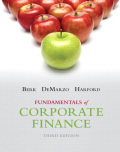
EAR (Effective Annual Rate): The effective interest rate refers to the rate of interest that is paid on an investment or loan or bonds after to take into consideration of compounding over a period of time.
APR (Annual Percentage Rate): The annual percentage rate refers to the rate of interest at which the annual simple interest is calculated.
To Explain: The difference between the effective annual rate and annual percentage rate.
Answer:
The main difference between both is the effective annual rate calculates the
Explanation of Solution
Difference between EAR and APR
| S. No. | Basis | Effective Annual Rate | Annual Percentage Rate |
| 1. | Definition | The effective annual rate is the interest rate charged on an amount annually, to take account of compounding during the year. | Annual percentage rate is simple interest rate charged on an amount annually, without taking account of the compounding during the year. |
| 2. | Base | With the help of effective annual rate compound interest can be calculated. | With the help of annual percentage rate, simple interest can be calculated. |
| 3. | Use | The effective annual rate is used for the evaluation of compounding loans like Credit card bills, mutual fund investments. | The annual percentage rate is used for the evaluation of mortgage and auto loans. |
| 4. | Interest occurrence | The interest which occurs at the regular intervals like monthly or quarterly is calculated at the effective annual rate. | The interest for a specific year can be calculated with the help of annual percentage rate. |
The effective annual rate and annual percentage rate both are different from each other mainly on the basis of the calculation of different interests.
Want to see more full solutions like this?
Chapter 5 Solutions
EBK FUNDAMENTALS OF CORPORATE FINANCE
- finance subjectarrow_forwardCould you help explain, what is the complete salary survey analysis, and ensuring the data is relevant and up-to-date? What is the job evaluation and compensation plan? How to ensure the final report is comprehensive, clearly structured, and aligned with the company vision?arrow_forwardThe maturity value of an $35,000 non-interest-bearing, simple discount 4%, 120-day note is:arrow_forward
- Carl Sonntag wanted to compare what proceeds he would receive with a simple interest note versus a simple discount note. Both had the same terms: $18,905 at 10% for 4 years. Use ordinary interest as needed. Calculate the simple interest note proceeds. Calculate the simple discount note proceeds.arrow_forwardWhat you're solving for Solving for maturity value, discount period, bank discount, and proceeds of a note. What's given in the problem Face value: $55300 Rate of interest: 10% Length of note: 95 days Date of note: August 23rd Date note discounted: September 18th Bank discount rate:9 percentarrow_forwardAll tutor giving incorrect solnarrow_forward
 Essentials Of InvestmentsFinanceISBN:9781260013924Author:Bodie, Zvi, Kane, Alex, MARCUS, Alan J.Publisher:Mcgraw-hill Education,
Essentials Of InvestmentsFinanceISBN:9781260013924Author:Bodie, Zvi, Kane, Alex, MARCUS, Alan J.Publisher:Mcgraw-hill Education,

 Foundations Of FinanceFinanceISBN:9780134897264Author:KEOWN, Arthur J., Martin, John D., PETTY, J. WilliamPublisher:Pearson,
Foundations Of FinanceFinanceISBN:9780134897264Author:KEOWN, Arthur J., Martin, John D., PETTY, J. WilliamPublisher:Pearson, Fundamentals of Financial Management (MindTap Cou...FinanceISBN:9781337395250Author:Eugene F. Brigham, Joel F. HoustonPublisher:Cengage Learning
Fundamentals of Financial Management (MindTap Cou...FinanceISBN:9781337395250Author:Eugene F. Brigham, Joel F. HoustonPublisher:Cengage Learning Corporate Finance (The Mcgraw-hill/Irwin Series i...FinanceISBN:9780077861759Author:Stephen A. Ross Franco Modigliani Professor of Financial Economics Professor, Randolph W Westerfield Robert R. Dockson Deans Chair in Bus. Admin., Jeffrey Jaffe, Bradford D Jordan ProfessorPublisher:McGraw-Hill Education
Corporate Finance (The Mcgraw-hill/Irwin Series i...FinanceISBN:9780077861759Author:Stephen A. Ross Franco Modigliani Professor of Financial Economics Professor, Randolph W Westerfield Robert R. Dockson Deans Chair in Bus. Admin., Jeffrey Jaffe, Bradford D Jordan ProfessorPublisher:McGraw-Hill Education





